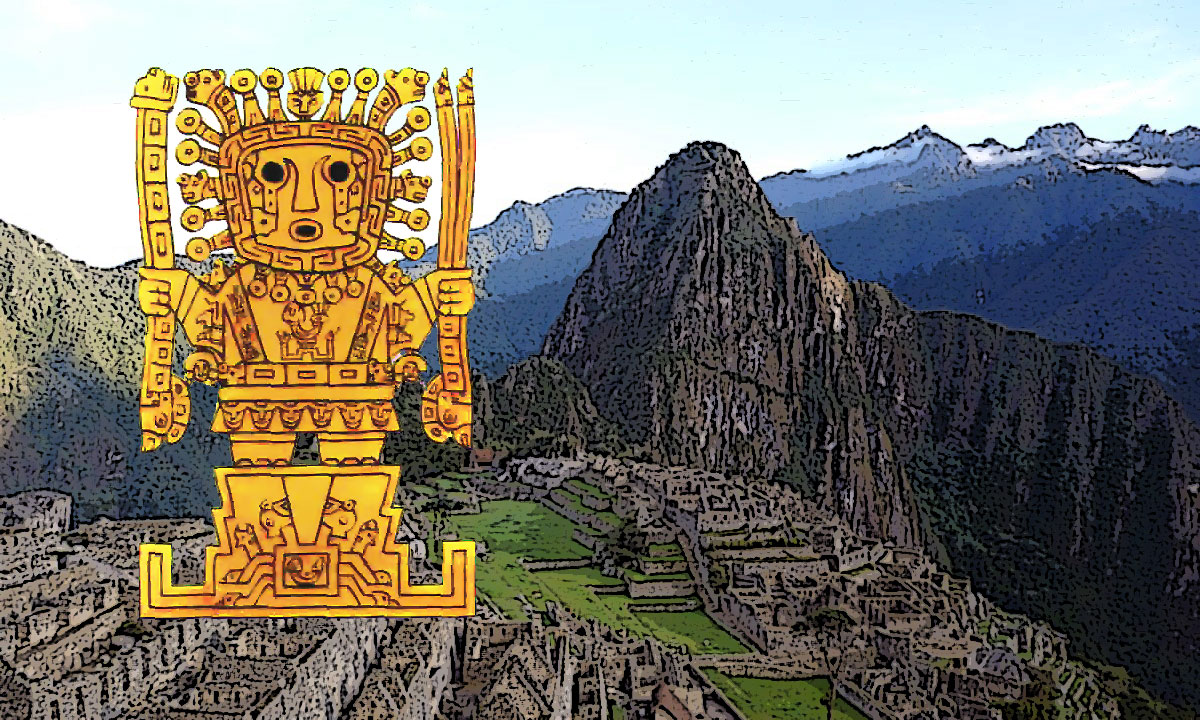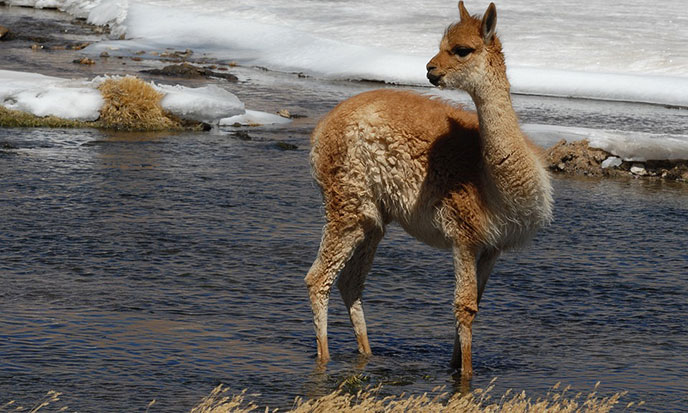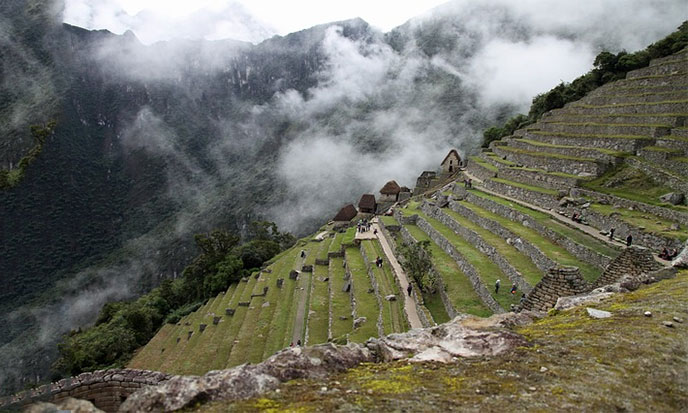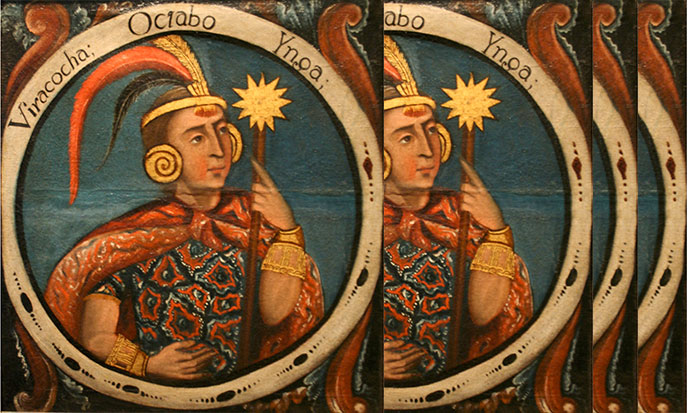
Many Christs took place in so many countries, from so many legends, at so many times. In the Andes – the second top of the world – thousands of years ago, came a Christ with white skin and a blond beard. His story is another sacred history.
Who was he? A European monk, such Brandan or Malo during our Middle Ages? A Hyperborean of Antiquity, with divine powers and sophisticated weapons? One of the terraforming gods who came to Earth long before? Maybe he was all three, one after another, as it is true that history repeats itself.
“All the ancient legends of the Andes are haunted by a male character shrouded in mystery. He is distinguished from the Andeans by his tall size, his beard and his light skin. Known by many different names throughout the Cordillera, it is always the same recognizable character, Tiki Viracocha, Sea Foam, a master of science and magic who came in times of trouble to sort the world out.” (source)Graham Hancock, L ’empreinte des Dieux, Pygmalion, 1996, pp. 53 sq

Viracocha Created All
Before Viracocha, the world was dark. Viracocha created the sun to whom he commanded to stand behind a black rock, the island of the sun emerged from Lake Titicaca. He also created the moon and the stars.
Then Viracocha created the tribes of the Andes, who came out of caves, springs within their respective territories. He attributed them each a costume, language and traditions.
According to Thor Heyerdahl (source)Early man and the ocean, 1978 the mythical character of Viracocha exists in a multitude of pre-contact cultures of South and Central America. According to various legends of these peoples, that character was tall, light-skinned, with a long beard and a large toga, kind of monk dress.
He would follow a route from North to South, civilizing various peoples that were in the way and giving them values and techniques, bringing them from the status of wilderness to that of civilized man. Viracocha introduced himself as the son of the sun. Just like Quetzalcoatl, Kukulkan or Cuchulann.
For various reasons, he often changed his place, continuing his route to the south to finally leave the American continent on a boat heading west and Polynesia.
The legends agree on the qualities of Viracocha and the natural authority he got from them. This creator god has different names depending peoples, Viracocha, Quetzalcoatl, Kon Tiki, but he keeps his essential attributes as a founder of civilization. (source)
He Came After The Flood
In those days, a terrible flood submerged the whole Earth and destroyed almost all of mankind. Viracocha appeared shortly after, like a savior.
“He spoke to men with love and gentleness, calling them his sons, pledging to love each other and to be charitable. His name was Kon Tiki Viracocha. But he was also called Huaracocha, Thunupa, Taapac, Tupaca or Illa. Wherever he went, he healed those who were sick and restored sight to blind people. He went in many directions, ordering a lot of works.

A Friend To The Poor
Before his arrival, the men were living in anarchy; many of them were naked as savages; they had no houses and lived in caves, which they left from time to time to hunt and gather what they could in nature.” (source)Graham Hancock, Imprint of the Gods, Pygmalion, 1996, pp. 53 sq Sea Foam was also the master of Lightning. The two bars he holds in his hands represent two flashes of lightning, for he commanded storms. Was he the one who built the andenes – these terraces that gave their name to the entire Cordillera?
“One day, Sea Foam emerged from a lake with a few associates. The white men with blond hair have taught everything to the natives, transforming them in a generation of time from a quasi-animal state to a civilization moral, policed and civilized. In particular, the ancient Peruvians remembered the Viracochas as the introducers of various arts, medicine, metallurgy, agriculture, breeding, writing (forgotten afterwards!)”
Holiness and Technology
They also gave them “an advanced expertise of the techniques in engineering and architecture.” (source)Graham Hancock, Imprint of the Gods, Pygmalion, 1996
 Incredible Viracocha! He acts like Jesus Christ or any charitable prophet. He preaches universal love and wants to put an end to human sacrifices. He teaches unexpected sciences and techniques to hunters-gatherers who, of course, love him. What a nice guy! “And he heals those who, among them, are sick.” (source)gospel of Thomas A holy man. Such is the portrait given by Graham Hancock. Hancock is at Tiahuanaco, before the portrait of Viracocha carved from a block of red stone:
Incredible Viracocha! He acts like Jesus Christ or any charitable prophet. He preaches universal love and wants to put an end to human sacrifices. He teaches unexpected sciences and techniques to hunters-gatherers who, of course, love him. What a nice guy! “And he heals those who, among them, are sick.” (source)gospel of Thomas A holy man. Such is the portrait given by Graham Hancock. Hancock is at Tiahuanaco, before the portrait of Viracocha carved from a block of red stone:
“As a disciple to his master’s feet, I sat on the floor of the vanished temple and watched the enigmatic face. Although it is almost erased, we can see that it represented a man at peace with himself and with very wide powers. The forehead is high, clear, the eyes are round, wide open.
Next to his head, strange animals were carved in stone: they are large prehistoric mammals with massive tails and members.
By contemplating this beautiful sculpture, the image that comes to my mind is that of a Viracocha magician, or sorcerer, a kind of Merlin the Enchanter adorned with beautiful and strange clothes, making fire come down from heaven to the earth.” (source)Graham Hancock, Imprint of the Gods, p. 78
And that’s exactly what he was. A magician. A healer. A holy man. A miracle worker. We understand the shock and grief that his departure has caused.
He Will Come Back
We understand why the peoples of the Andes have hoped his return across the centuries and millenia. As Christians await the return of Christ. And instead of god, the devil got back. Pizarro put an end to the myth in a pool of blood. But centuries earlier, the civilizing god of the Incas much resembled Quetzalcoatl, that of the Aztecs. The only difference lies in his name, which means Feathered Serpent. These strange names probably describe a know-how, a particular sign.
Quetzal, the bird, can fly. Coatl, the serpent, can swim in the waves. Were the Quetzalcoatl those who travel in submersible aircrafts? Those who fly and swim under water thanks to their magical ships? … At the other end of the world, in India, the Mahabharata tells us about the invaders of Rama’s empire, the Asvin. They had a special airplane that could navigate under water and in the sky. If the meaning of the Feathered Serpent can be understood so, what about the Sea Foam?

High Tech Tiki
Could this strange name describe the same thing? When a swimmer leaves the water, he may produce some bubbles, but no foam. On the other hand, when a submersible aircraft comes out of the water, he does so in a shower of foam. We can easily imagine that the appearance of a craft gushing out of a lake is likely to shock the primitives. They would have named him Sea Foam, the one who came out of Lake Titicaca in a shower of foam. Do not be shocked by the presence of technology at that time, it was common in numerous ancient legends.
Electricity, computer, UFO, nuke bomb, telescope, many of our “modern” inventions have already existed in a distant past. Ecclesiastes does not say anything else.


